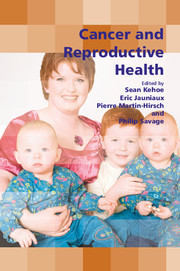Book contents
- Frontmatter
- Contents
- Participants
- Preface
- SECTION 1 Epidemiology, Genetics and Basic Principles of Chemotherapy and Radiotherapy
- SECTION 2 Fertility Issues and Paediatric Cancers
- SECTION 3 Gynaecological Cancers and Precancer
- SECTION 4 Diagnostic Dilemmas
- 13 Imaging techniques
- 14 Serum markers for gynaecological cancer in the reproductive years
- 15 Diagnostic dilemmas in cellular pathology
- SECTION 5 The Placenta
- SECTION 6 Non-Gynaecological Cancers
- SECTION 7 Multidisciplinary Care and Service Provision
- SECTION 8 Consensus Views
- Index
15 - Diagnostic dilemmas in cellular pathology
from SECTION 4 - Diagnostic Dilemmas
Published online by Cambridge University Press: 05 October 2014
- Frontmatter
- Contents
- Participants
- Preface
- SECTION 1 Epidemiology, Genetics and Basic Principles of Chemotherapy and Radiotherapy
- SECTION 2 Fertility Issues and Paediatric Cancers
- SECTION 3 Gynaecological Cancers and Precancer
- SECTION 4 Diagnostic Dilemmas
- 13 Imaging techniques
- 14 Serum markers for gynaecological cancer in the reproductive years
- 15 Diagnostic dilemmas in cellular pathology
- SECTION 5 The Placenta
- SECTION 6 Non-Gynaecological Cancers
- SECTION 7 Multidisciplinary Care and Service Provision
- SECTION 8 Consensus Views
- Index
Summary
Introduction
There are many diagnostic dilemmas in gynaecological cellular pathology, spanning across all age groups. These include classification of diseases including tumour nomenclature, staging problems that are dependent on appropriate tissue sampling and iatrogenic pathology. Diagnostic dilemmas also arise as a result of variation in tissue sampling and handling and this is most apparent in premenopausal women in whom, quite often, limited samples are taken. The protocols for tissue handling may also vary according to age group, particularly the use of frozen sections and aspiration cytology. For instance, in cervical cancer treatment in the young where fertility-sparing surgery must be considered, the role of frozen sections of pelvic lymph nodes is crucial. In older women, the use of frozen sections may not be as important. Similarly, ovarian cysts in the young can be aspirated for diagnosis while in older women these cysts can simply be removed.
In the reproductive age group, there are specific diagnostic dilemmas and these are even more problematic during pregnancy. There are also pregnancy-related pathological entities to consider and some of these may be problematic. The use of hormones also impacts on cellular pathology and such iatrogenic changes can be challenging at times, for example the apoplectic changes in leiomyomas with gonadotrophin-releasing hormone (GnRH) analogues and the problem with vaginal adenosis (which may lead to adenocarcinoma) in young females whose mothers used diethylstilbestrol during pregnancy.
Keywords
- Type
- Chapter
- Information
- Cancer and Reproductive Health , pp. 179 - 184Publisher: Cambridge University PressPrint publication year: 2008

